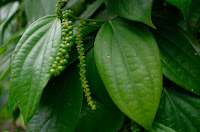Geologically speaking, the Seychelles, in the Indian Ocean, are the visible part of the continent that
 |
| The Seychelles archipelago |
once linked Africa to Asia ('Gondwana') before the continental drift. The western group of the Indian Ocean islands (Madagascar, Réunion, Mauritius, Rodrigues, the Comoros, and the Seychelles) is politically a sub-group of the Dark Continent.
This physical feature may account why these islands have retained a unique ecosystem. It is particularly true with the Seychelles, an archipelago of 115 islands, seen as a microcontinent. The Seychelles islands are of two types:
the granitic group: rocky with an elevation that can reach 914m,
the outer islands: coral atolls.
It is interesting to note that these are the only granitic oceanic islands in the world dating back to the late Precambrian. Until the 17th century, when they were disputed between the French and the British, the Seychelles were not inhabited. This may explain in turn why they have remained a natural paradise with an incredible variety of species both in the animal and vegetal worlds. The two best-known examples are the giant Aldabra tortoises and the coco de mer, a unique brand of coconut.
 |
| Aldabra tortoise |
 |
| Coco de mer |
The 45 granite islands of the Seychelles are the world's oldest ocean islands with their own rainforests. Each of the three major islands (Mahé, Praslin, La Digue) have managed to keep a specific natural environment.
Le Jardin du Roi (Spice Garden) on the island of Mahé is one of the best places to visit if you are interested in knowing more about the local flora in particular.
 |
| Le Jardin du Roi and its colonial house |
The present estate is not the original one, which was burnt down by mistake in the 18th century. At that time, a French trader and horticulturist, Pierre Poivre (1719-1786), originally from Lyon had
 |
| Pierre Poivre in Victoria |
started to import clove and nutmeg from the Moluccas (the Dutch 'Spice Islands' in the East Indies) in order to counter a lucrative business that had been a Dutch monopoly. Today's Spice Garden was recreated in order to keep the spice trade tradition. It is located on a hillside, in the southern part of Mahé island, near Anse Royale on the east coast. The original colonial house (built around 1860) has become a small museum. There is also a café and a restaurant nearby offering a stunning view of the rainforest as far as the ocean. The well-documented, self-guided tour offers three main discovery hikes in the garden:
a rainforest trail,
a garden walk,
and, a medicinal plant walk.
 |
| Map of the Spice Garden in Mahé |
There is a huge number of trees, plants, and spices that have been carefully numbered so that you can recognize them on the folders provided at the entrance. Here is a selected list that I found particularly interesting to recognize on my walking tour:
#
|
English name
|
Nom français
|
Latin
|
1
|
Allspice
|
Quatre-épices
|
Pimenta dioica
|
2
|
Camphor
|
Camphrier
|
Cinnamomum camphora
|
3
|
Cinnamon
|
Cannelier
|
Cinnamomum verum
|
4
|
Clove
|
Giroflier
|
Syzygium aromaticum
|
5
|
Coca
|
Coca
|
Erythroxylum novogranatense
|
6
|
Cocoa
|
Cacao
|
Theobroma cacao
|
7
|
Custard apple
|
Cœur de bœuf
|
Annona reticulata
|
8
|
Guava
|
Goyavier
|
Psidium guajava
|
9
|
Jackfruit
|
Jacquier
|
Artocarpus heterophyllus
|
10
|
Java/Water apple
|
Jamalac
|
Syzygium samarangense
|
11
|
Lemongrass
|
Citronnelle
|
Cymbopogon citratus
|
12
|
Mahogany
|
Acajou
|
Swietenia macrophylla
|
13
|
Mangosteen
|
Mangoustan
|
Garcinia mangostana
|
14
|
Monkey's apple
|
Pomme jacot
|
Mimusops coriacea
|
15
|
Nutmeg
|
Muscadier
|
Myristica fragrans
|
16
|
Orchid tree
|
Sabot de bœuf
|
Bauhinia variegata
|
17
|
Pepper
|
Poivrier
|
Piper nigrum
|
18
|
Sapodilla
|
Sapotillier
|
Manilkara zapota
|
19
|
Seychelles stilt palm
|
Latanier latte
|
Verschaffeltia splendida
|
20
|
Soursop
|
Corossolier
|
Annona muricata
|
21
|
Starfruit
|
Carambole
|
Averrhoa carambola
|
22
|
Tamarind
|
Tamarinier
|
Tamarindus indica
|
This fascinating walking tour takes about 2 hours to complete. Needless to say, it is really interesting and quite a learning experience.
Christian Sorand
Illustrations:
 |
| Alpinia |
 |
| Add caption |
 |
| Pomelo |
 |
| Pineapple |
 |
| Cinnamon |
 |
| Young cinnamon leaves |
 |
| Cinnamon branch |
 |
| Pepper |
 |
| Green pepper branch |
 |
| Patchouli |
 |
| Patchouli leaves |
 |
| Coco de mer tree |
 |
| Coco de mer |
 |
| Ylang-Ylang |
 |
| Coca |
 |
| Soursop |
 |
| Sugar cane |
Links:
 |
| Spice Garden sea view. |

















































